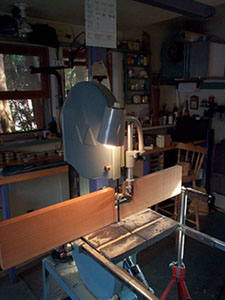Quartersawn Wood for
Musical Instruments
The wood used in stringed instruments must be specially sawn by a method called "Quarter Sawing." Wood must be quarter-sawn for musical instruments so that the grain is compactly spaced, and so it can be planed down to very thin pieces without warping and twisting.
That's it--no magic, just plain simple reasons. And why does quarter-sawing wood do this? That's simple too. Warping in wood occurs because the wood shrinks as it dries. When the wood shrinks, it's got to go somewhere, because all its cells are getting packed closer together. And it all shrinks toward the center of the tree.
Now when wood is "lumber sawn" or "plank sawn", the sawyer just starts at one edge of the log and slices off pieces parallel to each other, like slicing a tomato. So if you look at the end of a piece of common lumber, you will see the grain is a series of arches, like this |((((|. Since the grain all points toward the center of the log, both edges of this board will curl toward the center.
But a quarter-sawn plank is sawn right through the middle of the log. All the planks' edges point toward the center of the log. So if you look at the end of the plank, it looks like this: ||||||||||||. So all the shrinking will happen from one edge toward the other edge, and no curling will result. That's the whole secret of quarter sawing. (It also makes for a very beautiful grain in the wood.)

